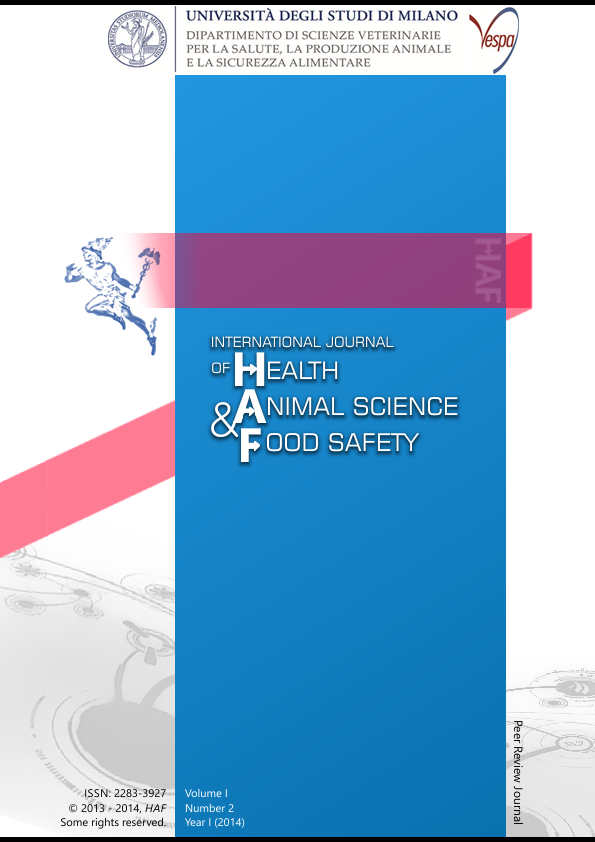Abstract
Zinc (Zn) salts are often used as nutritional additives in order to promote gut health. The aim of the present study was to assess the effect of two widely used additives in feedstuff, on the intestinal epithelium. In particular, the effect of zinc oxide (ZnO) and zinc chloride (ZnCl2) was investigated in human (INT-407) and porcine (IPI-2I) cell line models. The effect of Zn sources on IPI-21 and INT-407 cell lines was evaluated by a colorimetric viability test using an incubation period of 3 and 24 hours under serum-free conditions. INT407 and IPI-2I showed to be a suitable model of the intestine and a simple tool to investigate the role of Zn supplements. INT407 showed to be the most sensible model to Zn supplements considered, whereas IPI-2I were more resistant. The results of this study contribute to determine the role of zinc in human and swine intestinal epithelium. However, further in vivo experiments may be done to clarify the contribution of Zn supplements in gut health and to improve Zn supplementation in animal feed and in human formulations.
Riferimenti bibliografici
Baldi A., Losio M.N., Cheli F., Rebucci R., Sangalli L., Fusi E., Bertasi B., Pavoni E., Carli S., Politis I., 2004. Evaluation of the protective effects of alpha-tocopherol and retinol against ochratoxin A cytotoxicity. British Journal of Nutrition 91, 507-512.
Cencic A., Langerholc T., 2010. Functional cell models of the gut and their applications in food microbiology. International Journal of Food Microbiology. 141, 4-14.
Fraker P.J., King L.E., Laakko T.,Vollmer T.L., 2000. The dynamic link between the integrity of the immune system and zinc status. Journal of Nutrition. 130, 1399 – 1406.
Frieke C. 2000. Function and mechanism of zinc. Journal of nutrition 130, 1437S – 1446S.
Kaeffer B., Bottreau E., Velge P., Pardon P., 1993. Epithelioid and fibroblastic cell lines derived from the ileum of an adult histocompatible miniature boar (d/d haplotype) and immortalized by SV40 plasmid. European Journal of Cell Biology. 62, 152-162.
Langerholc T., Maragkoudakis P.A., Wollgast J., Gradisnik L., Cencic A., 2011. Novel and established intestinal cell line models – An indispensable tool in food science and nutrition. Trends in Food Science & Technology. 22, 11-20.
Lönnerdal B., 2000. Dietary Factors Influencing Zinc Absorption. Journal of Nutrition. 130, 1378-1383.
Owusu-Asiedu A., Nyachoti M.C., Marquardt R. R., 2003. Response of early-weaned pigs to an enterotoxigenic Escherichia coli (K88) challenge when fed diets containing spray-dried porcine plasma or pea protein isolate plus egg yolk antibody, zinc oxide, fumaric acid, or antibiotic. Journal of Animal Science. 81, 1790-1798.
Poulsen H.D., 1995. Zinc Oxide for Weanling Piglets 45, 159-167.
Rebucci R, Sangalli L, Fava M, Bersani C., Cantoni C.A, Baldi A., 2007. Evaluation of functional aspects in Lactobacillus strains isolated from dry fermented sausages Journal of Food Quality 30, 187–201.
REGOLAMENTO (CE) N.1831/2003 del Parlamento europeo e del Consiglio del 22 settembre 2003 sugli additivi destinati all'alimentazione animale. Gazzetta ufficiale dell'Unione europea L 268/29-42.
Roselli, M., Finamore, A., Garaguso I., Britti M.S., Mengheri, E., 2003. Zinc oxide protects cultured enterocytes from the damage induced by Escherichia coli. Journal of Nutrition. 133, 4077–4082.
Roselli M., Finamore A., Britti M.S., Bosi P., Oswald I., Mengheri E., 2005. Alternatives to in-feed antibiotics: evaluation of probiotics, zinc or organic acids as protective agents for the intestinal mucosa. Comparison of in vitro with in vivo results. Animal Research, 54, 1-16.
Sargeant H.R., Shaw M.A, AbuOun M., Collins J.M., Woodward M.J., La Ragione R.M., Miller H.M., 2010. The metabolic impact of zinc oxide on porcine intestinal cells and enterotoxigenic Escherichia coli K88. Livestock Science. 133, 45–48.
Sargeant, H.R., Miller, H.M., Shaw, M. 2011. Inflammatory response of porcine epithelial IPEC J2 cells to enterotoxigenic E. coli infection is modulated by zinc supplementation. Molecular Immunology. 48, 2113–2121.
This work is licensed under a CC BY-SA 4.0 international

